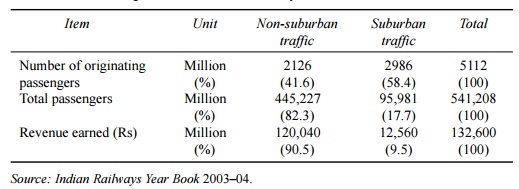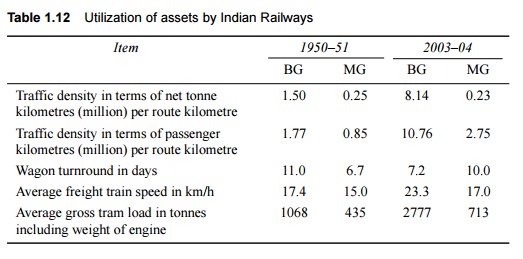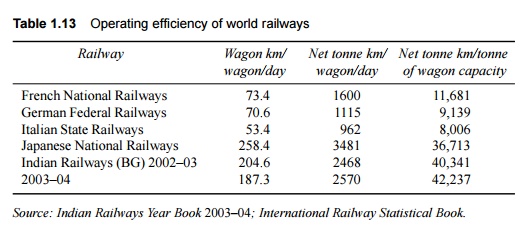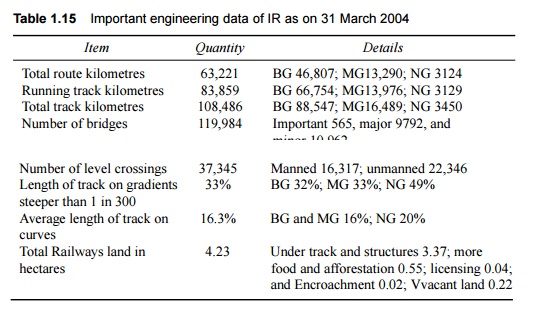Chapter: Civil : Railway Airport Harbour Engineering : Railway Engineering : History and General Features of Indian Railways
Important Statistics of Indian Railways
Important Statistics of Indian Railways
Certain statistical
data of Indian Railways regarding passenger and freight traffic, operating
efficiency, railway employees and their training, and social costs of Indian
Railways as well as engineering data are given in the following sections.
1 Passenger Traffic
Indian Railways carried 5112 million originating
passengers in 2003-04. Some of the salient features of passenger traffic are
given in Table 1.10.
Table
1.10 Passenger
traffic on Indian Railways

The
analysis of passenger figures for the last 50 years leads to the following
conclusions.
1. Over
the years, there has been a steady increase in passenger traffic output in
terms of passenger kilometres.
2. Since
1950-51, originating passengers have increased by 298% and passenger kilometres
by 71.3%.
3. Suburban
as well as mail/express traffic has shown a higher rate of growth since 1950-51
than the overall average growth rate.
2 Freight Traffic
With the pace of
economic growth picking up, Indian Railways is being called upon to provide
greater and stronger infrastructure support to the economy. Some important
statistics on revenue-earning freight traffic for the year 1950-51 as well as
those for 2003-04 are given in Table 1.11.
Table
1.11 Freight traffic
on Indian Railways

The Railways as a means
of transport are more suitable (for carrying) bulk traffic in train loads,
which is mainly offered by the core sector. However, there has been a decline
in the Railways, share of transport, particularly in the case of cement,
petroleum, and iron and steel, largely on account of competition from other
modes of transport, namely, highways, pipelines, coastal shipping, etc.
The Railways, besides
rationalization of the freight structure and effecting no across-the-board
increase in freight rates during the last two years, has taken several
initiatives to retain and attract traffic.
3 Utilization of Assets
The utilization indices of tracks and other assets
for the year 1950-51 as well as for the year 2003-04 are given in Table 1.12.
Table
1.12 Utilization of
assets by Indian Railways

4 Operating Efficiency Index
The operating
efficiency indices of Indian Railways compare favourably with some advanced
railway systems of the world as shown in Table 1.13.
Table
1.13 Operating
efficiency of world railways

5 Railway Employees
Indian Railways has
employed a workforce of 1.441 million employees with a wage bill of Rs 209,280
million during the year 2003-04 as per the break up given in Table 1.14.
Table
1.14 Staff strength
as on 31 March (in thousands)

Training of Railway Employees
Indian Railways has
developed its own facilities for conducting extensive training programs for its
officers and staff to enable them to improve upon their skill/abilities and
equip them with the latest technological developments. Training for officers is
organized in six centralized training institutions (CTIs):
1. The
Railway Staff College, Vadodra
2. Indian
Railways Institute of Civil Engineering, Pune
3. Indian
Railways Institute of Signal and Telecommunication Engineering, Secunderabad
4. Indian
Railways Institute of Mechanical Engineering, Jamalpur
5. Indian
Railways Institute of Electrical Engineering, Nasik
6. Indian
Railways Institute of Transport Management, Lucknow
Apart from probationary training, the
CTIs also cater to the various specialized training needs of serving officers.
The Railway Staff College provides inputs in general management, strategic
management, and function-related areas for serving railway officers. Other CTIs
conduct specialized technical training courses in their respective functional
areas.
The training needs of
non-gazetted staff are being taken care of by over 200 training centres located
in different parts of the country. Training has been made mandatory at
different stages to make it more effective for staff belonging to some of the
safety categories.
6 Social Costs of Indian Railways
Indian Railways is a public utility undertaking of
the Government of India. They do not have the freedom to adjust their freight
and fare rates corresponding to the increase in the prices of the various
inputs used by them. They also carry certain essential commodities, as also
passenger traffic, at rates which do not even cover their cost of movement. In
addition, traffic bound for flood-affected and drought-hit areas is carried at
concessional rates. Certain non-remunerative branch lines are also being operated
purely in public interest. Such social obligations, which Indian Railways has
carried out all along, are not usually borne by purely commercial undertakings.
Losses incurred on this account are termed Social Service Obligation.
The net Social Service Obligation borne
by IR in 2003-04 was Rs 38,390 million excluding staff welfare cost (Rs 12,770
million) and law and order cost (Rs 7750 million).
The
main items involved in this Social Service Obligation are the following.
(a) Essential
commodities carried at concessional rates below actual costs such as food
grains, salt, fodder, sugarcane, edible oils, and fruit and vegetables. (Rs
1100 million).
(b) Subsidized
suburban and some other passenger services (Rs 8070 million for suburban
traffic only).
(c) 112
uneconomic branch lines (Rs 4100 million).
(d) Freight
concessions on relief material and other miscellaneous social costs including
expenditure on Railway Protection Force (RPF) and Government Railway Police
(GRP).
(e) Staff
welfare measures such as health, education, and subsidized housing (12,770
million).
(f) Law
and order cost (Rs 7750 million).
Table 1.15 Important engineering
data of IR as on 31 March 2004

Related Topics